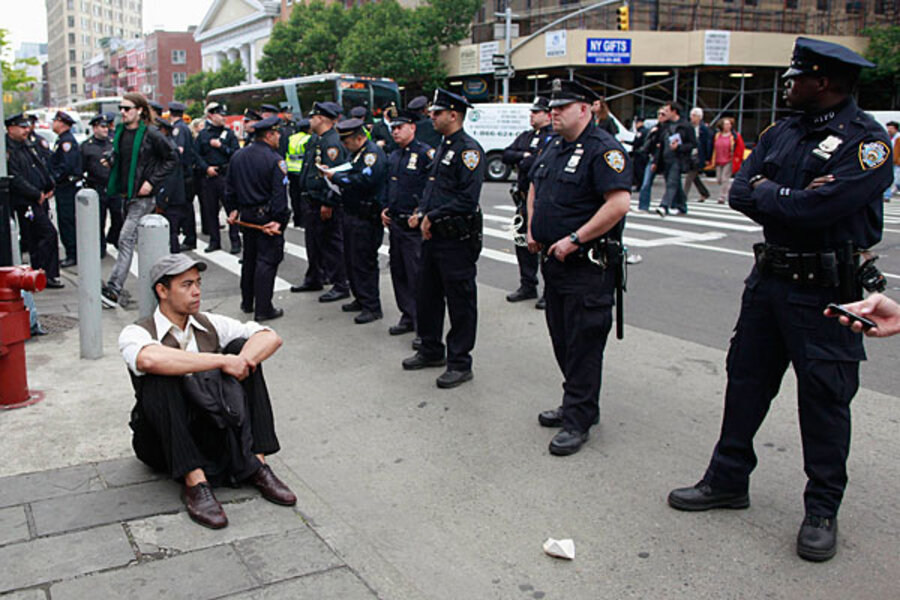May Day: Occupy movement returns, but can it win converts?
| NEW YORK
The Occupy movement kicked off its “spring awakening” in New York’s Bryant Park with a mini-replica of Occupy Wall Street efforts from last fall – free food, a skills exchange, and plenty of noise and soap-box style rhetoric.
But the movement, which was displaced from its Wall Street area encampment by the New York Police Department last November, mainly used the midtown park as a staging area with groups of 40 to 50 mostly youthful protesters at a time marching to nearby corporate headquarters.
“Pay your taxes!” chanted one group outside of News Corporation, which owns Fox News and The Wall Street Journal. “No New York City taxes!” they yelled outside the building housing the hedge fund Paulson & Co. The NYPD monitored the protests and made some isolated arrests of about seven people through midafternoon, according to the National Lawyers Guild, which was monitoring the events.
Protest organizers said that the goal of the day, aside from much of the anticorporate rhetoric, was to show that it was back after a relatively dormant winter.
“We want to displace the narrative that this is a fad and disappearing,” says Mark Bray, a spokesman for the Occupy movement. “We want to show that we are building a long-term social movement.”
Outside observers believe it’s important for the Occupy movement that the May Day protests appear successful. “There have been lots of false starts,” says George Ciccariello-Maher, a political scientist at Drexel University in Philadelphia.
“This is the next big stage,” says Mr. Ciccariello-Maher, who is a specialist in social movements. “They have to be able to show they can attract the numbers, not just do political lobbying.”
Much of the May Day rhetoric was way to the left of even the liberal Democrats.
At an impromptu press conference in Bryant Park, guitarist Tom Morello of Rage Against the Machine, said that gross economic inequality “is not only morally wrong, it is a crime.”
Economist Dennis Jacobe of Gallup, a polling company in Princeton, N.J., says most Americans would be hard-pressed to consider earning a lot of money a crime. “That is a big step,” he says.
In polls, he says, most people indicate that they think taxes are fair, but if they are asked if the wealthy should pay more, they agree. But in a recent poll, Gallup also found that half of Americans felt taxes were fair and the other half thought they were too high.
In addition, he says, Americans are loath to add taxes to the rich because they think that they, too, might become wealthy. “We still have a lot of upward mobility in the US,” he says. “In the back of everyone’s mind is: If you tax the wealthiest, I might be one of them.”
After several hours of protest in midtown Manhattan, the protesters left Bryant Park for Union Square, where Mr. Morello and others planned to perform. The marchers took up about six city blocks, with some participants singing “This Land is Your Land,” and chanting, "Whose Streets? Our Streets!" The police kept pace with motor scooters, while people watched from office windows along Fifth Avenue.
At Union Square they planned to hear more of the music of the disenfranchised from Mr. Morello and other musicians. Then, late in the day, they planned to walk to Wall Street with labor, interfaith, and other organizations. Once there, they planned on a “People’s Assembly,” a quirky system of participatory democracy that aims to work out consensus by debate and hand signals, such as wiggling of fingers.
Protester Buddy Bolton of New York said he hoped the day would result in more exposure and more recognition in the community about the goals of the Occupy movement.
“Time will tell if that happens,” he says. “If there are more laws passed by Congress and they address some of our concerns about student loans and other laws concerning economic justice and black people.”





